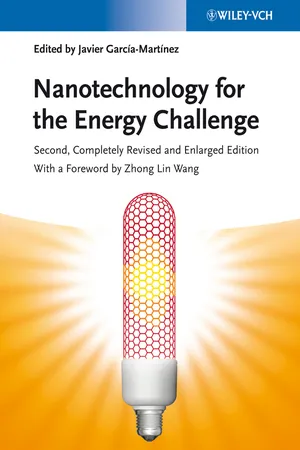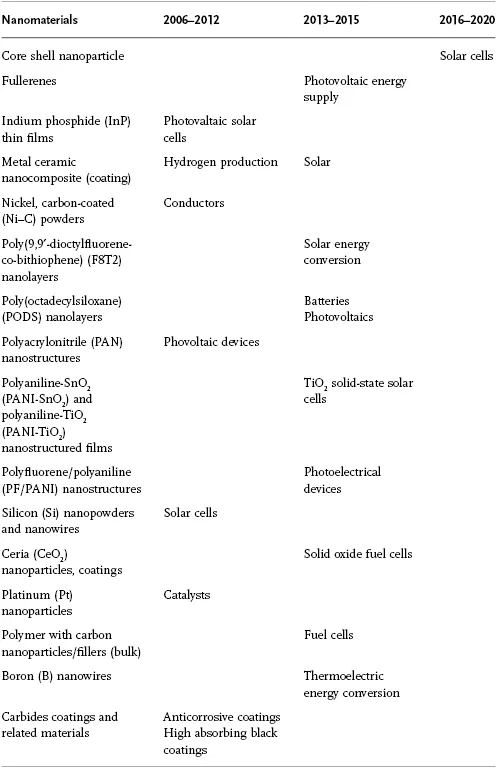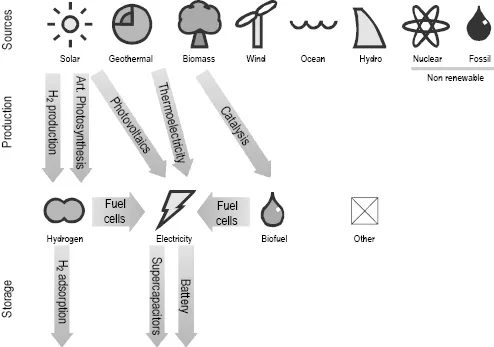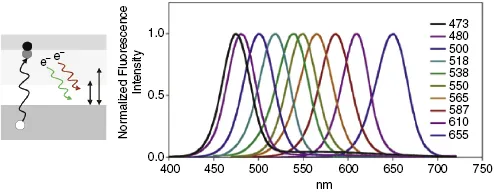1.1 Energy Challenges in the Twenty-first Century and Nanotechnology
One of the greatest challenges for mankind in the twenty-first century is its over-reliance on the diminishing fossil fuels (coal, oil, natural gas) as primary energy sources (Figure 1.1). Fossil fuels are nonrenewable resources that take millions of years to form. Consequently their reserves are depleted much faster than new ones are formed and/or discovered. While concerns over fossil fuel supplies are often the direct or indirect causes of regional and global conflicts, the production, transmission and use of fossil fuels also lead to environmental degradation. Combustion of carbon-based fossil fuels generates not only air pollutants, for example, sulfur oxides and heavy metals, but also CO2, the infamous greenhouse gas widely believed to be the culprit of global climate change. One of the solutions to this energy challenge, on the one hand, relies upon increasing the efficiency in production, transmission and utilization of the remaining fossil fuels while reducing their negative impacts on the environment. On the other hand, technologies and infrastructures have to be developed or improved in preparation for the smooth transition to the alternative and renewable energy sources, that is, nuclear power, solar energy, wind power, geothermal energy, biomass and biofuels, hydropower and so on.
Technological advancement, as shown by history, will play a pivotal role in this path to a more sustainable energy future. As defined by the International Energy Agency (IEA) [1], there are three generations of renewable energy technologies. The first generation technologies (including hydropower, biomass combustion, geothermal power and heat) emerged from the industrial revolution at the end of the nineteenth century. The second generation technologies include solar heating and cooling, wind power, bioenergy and solar photovoltaics. These technologies are now entering markets as a result of continuous investments in their research and development since the 1980s, which were largely driven by energy security concerns linked to the oil crisis in the 1970s. The third generation technologies currently under development include advanced biomass gasification, biorefinery technologies, concentrating solar thermal power, geothermal power, ocean tide and wave energy and so on.
The rapid evolution of nanoscience and nanotechnology (the study and control of materials and phenomena at length scales between 1 and 100 nm) during the past two decades has demonstrated that nanotechnology holds the keys to many of the technological advancements in the energy sector, which relies, at least in part, on having novel materials with superior properties. According to the “Roadmap Report Concerning the Use of Nanomaterials in the Energy Sector” from the Sixth Framework Program [2], the most promising application fields of nanotechnology or nanomaterials for the energy production domain will be in photovoltaics, hydrogen conversion (hydrogen production, fuel cells) and thermoelectricity (see Table 1.1 for the timeframe of possible industrial applications of a few exemplary nanomaterials).
Table 1.1 Timeframe of possible industrial applications for nanomaterials.
Adapted with permission from [2].
This book intends to present a comprehensive overview of the up-to-date progress in various important fields of nanotechnology research and development that are closely related to sustainable energy production, storage and usage. This chapter, in particular, mainly serves as an “overview” of the book, with an emphasis on sustainable energy production.
Nanotechnology intervenes at a number of stages in the energy flow that starts from the primary energy sources and finishes at the end user. The growing and diffuse limits of what can be considered as energy and the complex flows of energy in society and ecosystem make it impossible to draw an unequivocal definition of energy production. Herein, the term “energy production” encompasses all processes that convert energy from primary energy sources to secondary energy sources or forms. Energy production processes that are associated with nonrenewable energy sources, that is, fossil fuels (and nuclear power), and a few renewable sources, that is, ocean wave energy, wind energy and hydropower, will not be covered. However, we have included a chapter on the contributions of nanocatalysis in fuel production because of many recent advances in a more efficient production and transformation of various fuels thanks to catalysis with novel nanomaterials.
In Figure 1.2, the energy production processes where nanotechnology has potential key roles are grouped in the arrows of the upper half while the arrows in the lower half depict where nanotechnology may play significant parts in the energy storage or transportation processes. Part One and Part Two of this book will deal with these two topics respectively, while Part Three will revolve around how nanotechnology may positively impact on the efficient usage and sustainability of energy, as well as the environmental protection aspects.
1.2 Nanotechnology in Energy Production
1.2.1 Photovoltaics
Photovoltaic cells, more commonly known as solar cells, are devices that convert the energy radiating from the sun that reaches the earth in the form of light directly into electricity. The phenomenon and principle of photoelectric effect, that is, direct generation of electricity from light, was first discovered by the French physicist A. Becquerel in 1839 [3]. In a solar cell, when photons are absorbed by the semiconducting materials, mobile electron hole pairs (excitons) are generated. Once the excitons are separated, via drift or diffusion, the electrons can be directed to power an external load.
There have been three generations of photovoltaic technologies [4]. First generation solar cells are built on high-quality single crystalline silicon wafers, and consist of large-area, single p-n junction diodes, which can achieve very high efficiency (close to the theoretical efficiency of 33%) but their production costs are prohibitively high. Second generation solar cells, represented by thin-film devices based on cadmium telluride (CdTe), copper indium gallium selenide (CIGS), amorphous silicon and micromorphous silicon, require lower energy and cost in production. Unfortunately, they suffer from much reduced energy conversion efficiencies compared to the first generation because of the defects inherent in the lower-quality processing methods. Third generation solar cell technologies aim to increase the efficiency of second generation solar cells while maintaining low production costs. There are generally three approaches adopted: use of multijunction photovoltaic cells, light concentration, and use of excess thermal generation to enhance voltages or carrier collection (e.g., photovoltaic thermal hybrid cells). Nanostructured semiconducting materials hold the promise of achieving high efficiency at low cost.
Nanocrystal quantum dots (NQDs) [5] are nanometer-scale single crystalline particles of semiconductors, for example, Si (Figure 1.3). Due to the quantum confinement effect, their light absorption and emission wavelengths can be controlled by tailoring the size of the NQDs (Figure 1.4). In addition, researchers at the National Renewable Energy Laboratory (NREL; Golden, Colorado, USA) recently showed that silicon nanocrystals can produce two or three excitons per high-energy photon of sunlight absorbed, in comparison to bulk Si which can only produce one exciton per high-energy photon. Using nanocrystals as the light absorbing materials, typically on a supporting matrix of conductive polymers or high surface area mesoporous metal oxides (e.g., TiO2), the nanocrystal solar cells have a theoretical energy conversion efficiency of 40% in contrast to that of typical solar panels based on bulk Si (around 20%) [6].
Nanocrystal solar cells can be tuned to absorb light of different wavelengths by adjusting the size of the nanocrystals [7]. In addition, the absorber layer thickness in the nanostructured cells can be reduced down to 150 nm, 10 times lower than that of classical thin-film solar cells. For thin-film multilayered cells, using nanocrystalline materials also helps achieve a regular crystalline structure, which further enhances the energy conversion effic...





